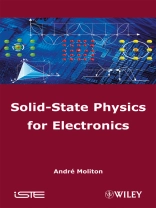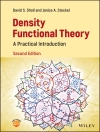Describing the fundamental physical properties of materials used in electronics, the thorough coverage of this book will facilitate an understanding of the technological processes used in the fabrication of electronic and photonic devices. The book opens with an introduction to the basic applied physics of simple electronic states and energy levels. Silicon and copper, the building blocks for many electronic devices, are used as examples. Next, more advanced theories are developed to better account for the electronic and optical behavior of ordered materials, such as diamond, and disordered materials, such as amorphous silicon. Finally, the principal quasi-particles (phonons, polarons, excitons, plasmons, and polaritons) that are fundamental to explaining phenomena such as component aging (phonons) and optical performance in terms of yield (excitons) or communication speed (polarons) are discussed.
สารบัญ
Foreword xiii
Introduction xv
Chapter 1. Introduction: Representations of Electron-Lattice Bonds 1
1.1. Introduction 1
1.2. Quantum mechanics: some basics 2
1.3. Bonds in solids: a free electron as the zero order approximation for a weak bond; and strong bonds 6
1.4. Complementary material: basic evidence for the appearance of bands in solids 10
Chapter 2. The Free Electron and State Density Functions 17
2.1. Overview of the free electron 17
2.2. Study of the stationary regime of small scale (enabling the establishment of nodes at extremities) symmetric wells (1D model) 19
2.3. Study of the stationary regime for asymmetric wells (1D model) with L a favoring the establishment of a stationary regime with nodes at extremities 23
2.4. Solutions that favor propagation: wide potential wells where L 1 mm, i.e. several orders greater than inter-atomic distances 24
2.5. State density function represented in energy space for free electrons in a 1D system 27
2.6. From electrons in a 3D system (potential box) 32
2.7. Problems 40
Chapter 3. The Origin of Band Structures within the Weak Band Approximation 55
3.1. Bloch function 55
3.2. Mathieu’s equation 59
3.3. The band structure 66
3.4. Alternative presentation of the origin of band systems via the perturbation method 70
3.5. Complementary material: the main equation 79
3.6. Problems 81
Chapter 4. Properties of Semi-Free Electrons, Insulators, Semiconductors, Metals and Superlattices 87
4.1. Effective mass (m*) 87
4.2. The concept of holes 93
4.3. Expression for energy states close to the band extremum as a function of the effective mass 96
4.4. Distinguishing insulators, semiconductors, metals and semi-metals 97
4.5. Semi-free electrons in the particular case of super lattices 107
4.6. Problems 116
Chapter 5. Crystalline Structure, Reciprocal Lattices and Brillouin Zones 123
5.1. Periodic lattices 123
5.2. Locating reciprocal planes 125
5.3. Conditions for maximum diffusion by a crystal (Laue conditions) 128
5.4. Reciprocal lattice 133
5.5. Brillouin zones 135
5.6. Particular properties 137
5.7. Example determinations of Brillouin zones and reduced zones 141
5.8. Importance of the reciprocal lattice and electron filling of Brillouin zones by electrons in insulators, semiconductors and metals 146
5.9. The Fermi surface: construction of surfaces and properties 149
5.10. Conclusion. Filling Fermi surfaces and the distinctions between insulators, semiconductors and metals 154
5.11. Problems 156
Chapter 6. Electronic Properties of Copper and Silicon 173
6.1. Introduction 173
6.2. Direct and reciprocal lattices of the fcc structure 173
6.3. Brillouin zone for the fcc structure 178
6.4. Copper and alloy formation 181
6.5. Silicon 185
6.6. Problems 190
Chapter 7. Strong Bonds in One Dimension 199
7.1. Atomic and molecular orbitals 199
7.2. Form of the wave function in strong bonds: Floquet’s theorem 210
7.3. Energy of a 1D system 215
7.4. 1D and distorted AB crystals 224
7.5. State density function and applications: the Peierls metal-insulator transition 228
7.6. Practical example of a periodic atomic chain: concrete calculations of wave functions, energy levels, state density functions and band filling 233
7.7. Conclusion 239
7.8. Problems 241
Chapter 8. Strong Bonds in Three Dimensions: Band Structure of Diamond and Silicon 249
8.1. Extending the permitted band from 1D to 3D for a lattice of atoms associated with single s-orbital nodes (basic cubic system, centered cubic, etc.) 250
8.2. Structure of diamond: covalent bonds and their hybridization 258
8.3. Molecular model of a 3D covalent crystal (atoms in sp3-hybridization states at lattice nodes) 268
8.4. Complementary in-depth study: determination of the silicon band structure using the strong bond method 275
8.5. Problems 287
Chapter 9. Limits to Classical Band Theory: Amorphous Media 301
9.1. Evolution of the band scheme due to structural defects (vacancies, dangling bonds and chain ends) and localized bands 301
9.2. Hubbard bands and electronic repulsions. The Mott metal–insulator transition 303
9.3. Effect of geometric disorder and the Anderson localization 311
9.4. Conclusion 322
9.5. Problems 324
Chapter 10. The Principal Quasi-Particles in Material Physics 335
10.1. Introduction 335
10.2. Lattice vibrations: phonons 336
10.3. Polarons 352
10.4. Excitons 364
10.5. Plasmons 368
10.6. Problems 373
Bibliography 385
Index 387
เกี่ยวกับผู้แต่ง
Professor Andre Moliton is the head of the group Plastic Optoelectronics at the Xlim Research Institute in the Universite de Limoges, France. This group studies the optoelectronic systems, and micro-electronics and microtechnologies through the use of ion treatment and simulations.












